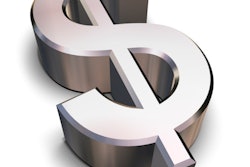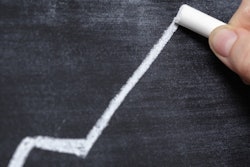
Annual dental spending is expected to increase to a projected $185 billion by 2025, a 52% increase from $122 billion in 2016, according to a new report. These projections are lower than those included in a report issued in July 2016 that predicted that spending on dental healthcare would reach nearly $200 billion in 2025.
The new report, published in Health Affairs (February 15, 2017), projects national health expenditures using recently released data from the U.S. Centers for Medicare and Medicaid Services (CMS). In the U.S., overall health spending is expected to increase 65% from $3.358 trillion in 2016 to $5.549 trillion in 2025, according to the CMS researchers who wrote the report.
"After an anticipated slowdown in health spending growth for 2016, we expect health spending growth to gradually increase as a result of faster projected growth in medical prices that is only partially offset by slower projected growth in the use and intensity of medical goods and services," said lead author Sean Keenan, PhD, an economist in the Office of the Actuary at CMS.
Growth estimates lowered
The projections in the current report predict increases in dental services spending from 2015 through 2025 (see table below). Just as with the previous report, the growth in spending is lower in dental services than in other categories.
| Annual percentage growth in U.S. healthcare spending by category | |||||
| Category | 2015 | 2016* | 2017* | 2019* | 2025* |
| Dental services | 4.2% | 3.7% | 5.0% | 5.1% | 4.6% |
| Physician & clinical services | 6.3% | 6.6% | 5.9% | 5.9% | 5.5% |
| Hospital care | 5.6% | 4.9% | 5.0% | 5.5% | 5.8% |
| Home healthcare | 6.3% | 5.9% | 6.2% | 6.6% | 7.0% |
| Prescription drugs | 9.0% | 5.0% | 5.7% | 7.0% | 6.4% |
From 2015 through 2025, healthcare's share of the economy is projected to grow from 17.8% to 19.9%. This is less than the July 2016 projection that healthcare's percentage of the economy would be 20.1% of the economy by 2025.
"In 2014 and 2015, when the largest impacts of the major coverage provisions of the Affordable Care Act were observed, health spending growth averaged 5.5%," the authors wrote. "For the period 2016-2025, spending is projected to grow similarly (5.6%) but to be largely influenced by changes in economic growth and population aging and not as much by changes in insurance coverage."
The latest projections for dental spending are revised downward from the previous report in July 2016. The current report predicts that dental spending was an estimated $121.9 billion in 2016 compared with $117.5 billion in actual spending in 2015.
| Projected U.S. dental services expenditures (in billions) | ||||
| Year | July 2016 report | February 2017 report | ||
| 2016 | $123.6 | $121.9 | ||
| 2019 | $143.7 | $141.3 | ||
| 2025 | $198.9 | $185.0 | ||
All projections in the new report are made assuming current healthcare laws and do not account for any potential legislative changes made during the projection period.
When asked by DrBicuspid.com why new projections were released only seven months after the previous ones were released, a Health Affairs spokesperson explained that the February release of projections was a return to CMS' previous timetable. In 2010, the Patient Protection and Affordable Care Act was signed into law after the projections were published (February 2010), which led to CMS releasing a second set of projections later that year. Projections continued to be released in the summer or fall after that because that is when the relevant data became available. However, as the logistical reasons for the summer publishing schedule have changed, CMS has gone back to the pre-2010 schedule.
Change in trends predicted
Other key findings of the report include that the uninsured population in the U.S. is expected to have declined by 1.2 million to 28 million in 2016, primarily caused by increases in people being covered by employer-sponsored plans and Medicaid. The percentage of the U.S. population with health insurance is projected to increase from 90.9% in 2015 to 91.5% in 2025, according to the report.
The largest projected slowdown in 2016 among major goods and services is prescription drug spending, projected to have grown only by 5.0% in 2016, down from an increase of 9.0% in 2015. This is due largely to the decrease in the use of drugs to treat hepatitis C, according to the report.
"The first two years of the report's projection period feature the slowest expected rates of growth for the period (4.8% in 2016 and 5.4% in 2017), as both Medicaid and private health insurance spending growth slow and Medicare spending growth remains low," the authors explained.
Medicaid enrollment growth slowed from an average of 8.4% in 2014 through 2015 to a projected less than 2% by 2017. However, for 2018 and beyond, Medicare and Medicaid expenditures are projected to grow faster than in 2016 through 2017 and more rapidly than private health insurance spending. This is because of expected growth in the use of Medicare services from its recent historic lows and because the Medicaid population is projected to trend toward being older and sicker.
Spending by federal, state, and local governments in the U.S. is expected to increase to 47% of healthcare spending in 2025, up from 46% in 2015 as more baby boomers enroll in Medicare. During the same period, healthcare spending by businesses and households is predicted to fall from 54% to 53%.
"This analysis finds that under current law and following the recent significant period of transition associated with coverage expansions, healthcare enrollment and spending trends are projected to revert to being fundamentally driven by changes in economics and demographics," the authors concluded.



















